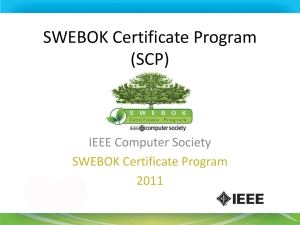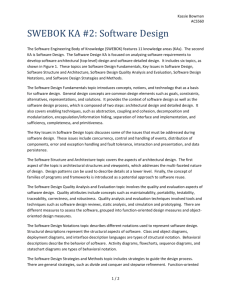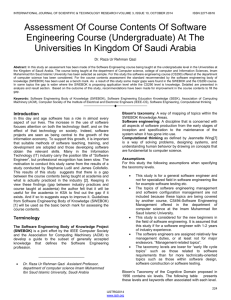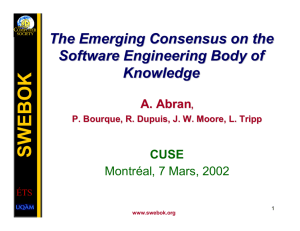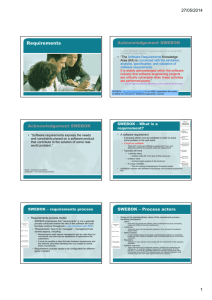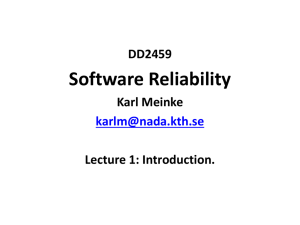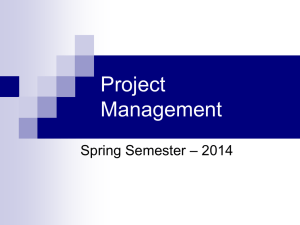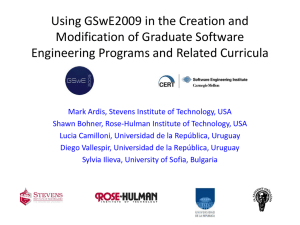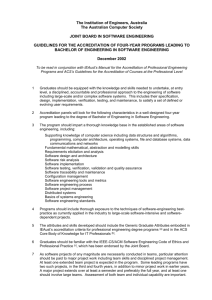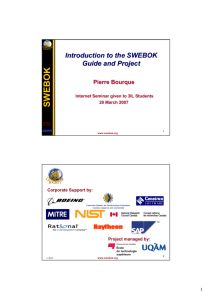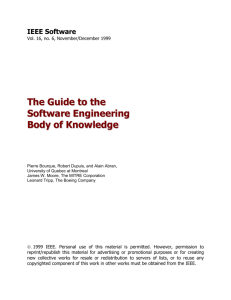swebok guide: an overview of trial usages in the field of education
advertisement
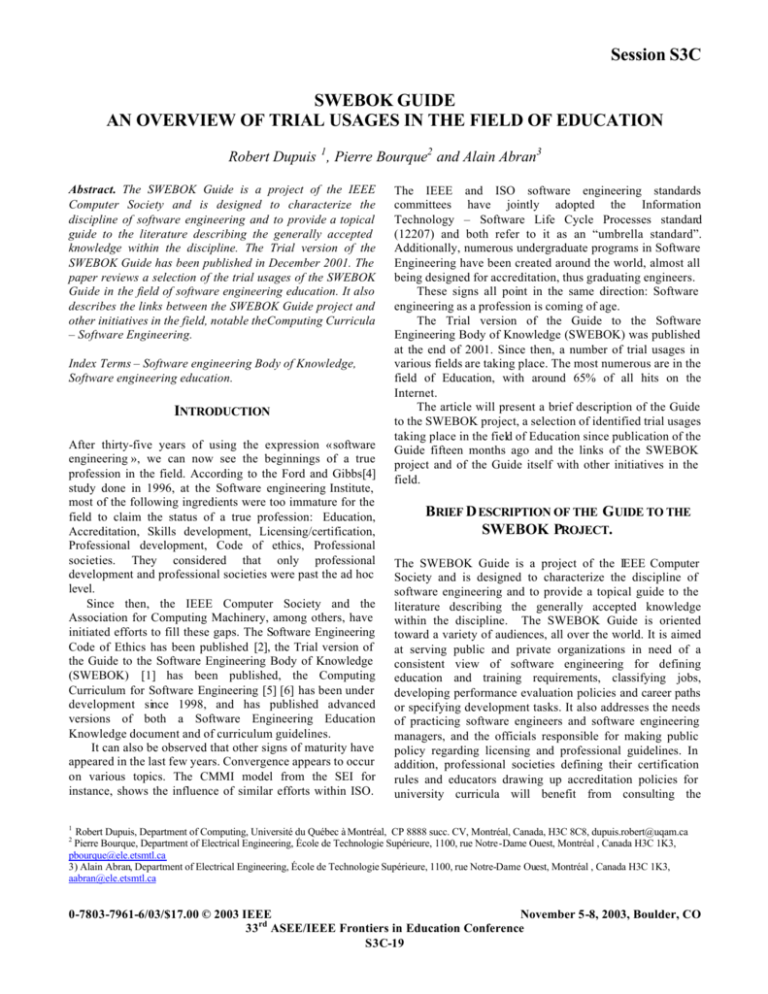
Session S3C SWEBOK GUIDE AN OVERVIEW OF TRIAL USAGES IN THE FIELD OF EDUCATION Robert Dupuis 1 , Pierre Bourque2 and Alain Abran3 Abstract. The SWEBOK Guide is a project of the IEEE Computer Society and is designed to characterize the discipline of software engineering and to provide a topical guide to the literature describing the generally accepted knowledge within the discipline. The Trial version of the SWEBOK Guide has been published in December 2001. The paper reviews a selection of the trial usages of the SWEBOK Guide in the field of software engineering education. It also describes the links between the SWEBOK Guide project and other initiatives in the field, notable theComputing Curricula – Software Engineering. Index Terms – Software engineering Body of Knowledge, Software engineering education. INTRODUCTION After thirty-five years of using the expression « software engineering », we can now see the beginnings of a true profession in the field. According to the Ford and Gibbs[4] study done in 1996, at the Software engineering Institute, most of the following ingredients were too immature for the field to claim the status of a true profession: Education, Accreditation, Skills development, Licensing/certification, Professional development, Code of ethics, Professional societies. They considered that only professional development and professional societies were past the ad hoc level. Since then, the IEEE Computer Society and the Association for Computing Machinery, among others, have initiated efforts to fill these gaps. The Software Engineering Code of Ethics has been published [2], the Trial version of the Guide to the Software Engineering Body of Knowledge (SWEBOK) [1] has been published, the Computing Curriculum for Software Engineering [5] [6] has been under development since 1998, and has published advanced versions of both a Software Engineering Education Knowledge document and of curriculum guidelines. It can also be observed that other signs of maturity have appeared in the last few years. Convergence appears to occur on various topics. The CMMI model from the SEI for instance, shows the influence of similar efforts within ISO. The IEEE and ISO software engineering standards committees have jointly adopted the Information Technology – Software Life Cycle Processes standard (12207) and both refer to it as an “umbrella standard”. Additionally, numerous undergraduate programs in Software Engineering have been created around the world, almost all being designed for accreditation, thus graduating engineers. These signs all point in the same direction: Software engineering as a profession is coming of age. The Trial version of the Guide to the Software Engineering Body of Knowledge (SWEBOK) was published at the end of 2001. Since then, a number of trial usages in various fields are taking place. The most numerous are in the field of Education, with around 65% of all hits on the Internet. The article will present a brief description of the Guide to the SWEBOK project, a selection of identified trial usages taking place in the field of Education since publication of the Guide fifteen months ago and the links of the SWEBOK project and of the Guide itself with other initiatives in the field. BRIEF D ESCRIPTION OF THE G UIDE TO THE SWEBOK PROJECT. The SWEBOK Guide is a project of the IEEE Computer Society and is designed to characterize the discipline of software engineering and to provide a topical guide to the literature describing the generally accepted knowledge within the discipline. The SWEBOK Guide is oriented toward a variety of audiences, all over the world. It is aimed at serving public and private organizations in need of a consistent view of software engineering for defining education and training requirements, classifying jobs, developing performance evaluation policies and career paths or specifying development tasks. It also addresses the needs of practicing software engineers and software engineering managers, and the officials responsible for making public policy regarding licensing and professional guidelines. In addition, professional societies defining their certification rules and educators drawing up accreditation policies for university curricula will benefit from consulting the 1 Robert Dupuis, Department of Computing, Université du Québec à Montréal, CP 8888 succ. CV, Montréal, Canada, H3C 8C8, dupuis.robert@uqam.ca Pierre Bourque, Department of Electrical Engineering, École de Technologie Supérieure, 1100, rue Notre-Dame Ouest, Montréal , Canada H3C 1K3, pbourque@ele.etsmtl.ca 3) Alain Abran, Department of Electrical Engineering, École de Technologie Supérieure, 1100, rue Notre-Dame Ouest, Montréal , Canada H3C 1K3, aabran@ele.etsmtl.ca 2 0-7803-7961-6/03/$17.00 © 2003 IEEE November 5-8, 2003, Boulder, CO 33 rd ASEE/IEEE Frontiers in Education Conference S3C-19 Session S3C SWEBOK Guide, as will students of software engineering and educators and trainers engaged in defining curricula and course content. From the outset, the question has arisen as to the depth of treatment the SWEBOK Guide should provide. The criterion of generally accepted knowledge was applied, which is distinguishable from advanced and research knowledge (on the grounds of maturity) and from specialized knowledge (on the grounds of generality of application). A second definition of generally accepted knowledge comes from the Project Management Institute: “generally accepted knowledge applies to most projects most of the time, and widespread consensus validates its value and effectiveness” [3]. The SWEBOK Guide is subdivided into ten Knowledge Areas, and the descriptions of the Knowledge Areas are designed to discriminate among the various important concepts, permitting readers to find their way quickly to subjects of interest. Upon finding such a subject, readers are referred to key papers or book chapters selected because they present the knowledge succinctly. The ten Knowledge Areas are listed in Table 1. Each of them is treated as a chapter in the SWEBOK Guide. TABLE I GUIDE KNOWLEDGE A REAS Software requirements Software design Software construction Software testing Software maintenance Software configuration management Software engineering management Software engineering process Software engineering tools and methods Software quality The SWEBOK Guide uses a hierarchical organization to decompose each Knowledge Area into a set of topics with recognizable labels. A two- or three-level breakdown provides a reasonable way to find topics of interest. In establishing a boundary, it is also important to identify what disciplines share such a boundary, and often a common intersection, with software engineering. To this end, the SWEBOK Guide also recognizes seven Related Disciplines, as listed in Table 2. Software engineers should, of course, know material from these fields. It is not, however, an objective of the SWEBOK Guide to characterize the knowledge of the Related Disciplines. TABLE II SWEBOK GUIDE RELATED DISCIPLINES Cognitive sciences and human factors Computer engineering Computer science Management and management science Mathematics Project management Systems engineering The Trial Version was developed through a managed consensus process involving roughly 8,000 comments collected through three review cycles involving, in total, close to 500 reviewers from over 40 countries. The SWEBOK project has received support from the following organizations: Boeing, the Canadian Council of Professional Engineers, Construx Software, the MITRE Corporation, the National Institute of Standards & Technology, the National Research Council of Canada, Rational Software, Raytheon, and SAP Labs. Canada. The SWEBOK Guide was endorsed in 2001 for trial usage by the Board of Governors of the IEEE Computer Society and is undergoing its final vote (in the Spring of 2003) by the International Organization for Standardization (ISO) for publication as Technical Report 19759. TRIAL USAGES OF THE SWEBOK G UIDE. As of March 2003, the Google web research engine found 2270 hits for the word SWEBOK. They represent usages in a number of areas. Hits in the area of education are the most frequent, representing roughly about 60% of the sites; a related category, training, accounting for another 5%. In this section, we present an overview of the types of educational usages of the SWEBOK Guide that can be observed. For each, we make a short description, followed by a selection of example trial usages within each type. Accreditation Criteria The following two examples of using the SWEBOK Guide as a basis for program accreditation can be cited. Efforts to link with ABET (Accreditation Board for Engineering and Technology, the accreditation body for the USA) are underway at the time of writing the article. • Japan. www.ipsj.or.jp/katsudou/acre/AccSE/minutes/2002/0712.txt • Canada. Especially in the province of British Columbia, but also at the national level, the Canadian Council of Professional Engineers. 0-7803-7961-6/03/$17.00 © 2003 IEEE November 5-8, 2003, Boulder, CO 33 rd ASEE/IEEE Frontiers in Education Conference S3C-20 Session S3C http://fie.engrng.pitt.edu/fie2001/papers/1409.pdf • Benediktsson, SWEBOK and Curriculum Development, U. of Iceland, 2000. A paper presented at a two days conference on the topic: Views on Software Development in the New Millennium • Panel on the topic at ICSE 2001. www.cs.uvic.ca/icse2001/progpanels.html • Jean-Guy Schneider, Swinburne University of Technology, Australia. Private Conference on SE Education. In Switzerland, Agile Processes in Software Engineering - An Educational Perspective Curriculum Design and Assessment Since the SWEBOK Guide is designed to describe the generally accepted knowledge in the field of software engineering, it can be used as at least one basis for curriculum design and assessment. • The SWEBOK Guide has been used to accelerate adoption of a software engineering capability development program within a major software development organization - the Securities Industry Automation Corporation (SIAC). dlib2.computer.org/conferen/cseet/1515/pdf/15150006 • IT Integrated Curricula and IT Courseware for K16, a project funded in the US by the National Science Foundation, reported at FIE2001. http://fie.engrng.pitt.edu/fie2001/papers/1409.pdf • Improvement of a masters level software engineering program at Southern Methodist University (SMU). dlib2.computer.org/conferen/cseet/1515/pdf/15150006. pdf • An innovative education program at the National Technological University. The NTU offers distance learning by choosing a course from the offering of its partners. The Guide is used as a reference in determining which course are included in the NTU offering. dlib2.computer.org/conferen/cseet/1515/pdf/15150006. pdf Included in Conferences Calls for Papers • Workshop on professionalism co-located with ICSE 2002 (http://www.icseconferences.org/2002/info/colocated.html) • ICSE 2002, Education track. cs.oregonstate.edu/icse2003 • The International Conference on Software Quality, organized by the Software Division of the American Society for Quality. www.icsq.org Various References in Software Engineering Education Newsletters • The Newsletter for Computer IT Education, Training & Tutorial Resources (http://www.intelinfo.com/newsletters/newsletter27.pd f) • Numerous references in the Forum on Software Engineering Education (FASE). http://tab.computer.org/fase/ Numerous references in courses The Guide or parts of it is very often included in the material of courses in many countries. In most cases, the included or cited material consists of the Knowledge Area (a chapter of the Guide) relevant to the course and/or the reference material recommended by the SWEBOK Guide in the given chapter. Software Engineering Education Conferences and Papers A number of software engineering education conference papers refer to the SWEBOK Guide. It ranges from descriptions of the Guide, to analyses of the maturation of Software Engineering as a profession, and the role of the Guide in this process, to simple reference to the Guide as one artifact among others in the field. • Fairley and Tripp, Software Engineering: Moving Fro m Craft to Profession, http://www.cse.ogi.edu/~dfairley/CraftToProfessio n.pdf • Lethbridge, What Knowledge Is Important to a SoftwareProfessional?, Computer, May 2000. Reference in a Software Engineering Education Related PhD Proposal • Armarego, Educating Requirements Engineers in Australia: a critical study, 1999. http://eng.murdoch.edu.au/~jocelyn/papers/phd_pro posal.doc References in Software Education Related Web Sites • A Chinese IT resources web site (www.iturls.com) recommends the SWEBOK Guide along with Pmbok and a few others as important education resources. • The Newsletter for Computer IT Education, Training & Tutorial Resources (http://www.intelinfo.com/newsletters/newsletter27.pd f) • Academic web site on SE Education. • http://ouray.cudenver.edu/~nflejeun/doctor alweb/Portfolio2/Products2/ReflectionStatements/Refl ection_D1_F1.htm 0-7803-7961-6/03/$17.00 © 2003 IEEE November 5-8, 2003, Boulder, CO 33 rd ASEE/IEEE Frontiers in Education Conference S3C-21 Session S3C • Listed as an Industry Training web site by the US Department of Energy. cio.doe.gov/ITReform/sqse/download/trng_orgs.doc • Lithuanian SE Laboratory at the Kauno technologijos universitetas . www.soften.ktu.lt/~virga/mag_atmintine/interneteka.ht ml • Model Curricula for Undergraduate Programs in Computer Science and Related Fields Compiled by Martin Dickey, Computer Science and Engineering Department, University of Washington. www.cs.washington.edu/homes/dickey/curricula/ These are only selected examples of trial usages of the SWEBOK Guide. It is clear from that list that in the first two years since its publication, the Trial version of the SWEBOK Guide has had an impact in the field. We can conclude from these selected examples, that the SWEBOK Guide is used not only by the practitioners of software engineering education in preparing and assessing curriculum, in preparing course material, as a reference in software engineering education newsletters and web sites, but also as a reference and an object of study presented in conferences and papers. We can conclude that the SWEBOK Guide is reaching one of its’ intended audiences: educators and trainers in the field. HARMONIZATION/S YNCHRONIZATION WITH OTHER INITIATIVES In the Spring of 2003, the project is gathering and analyzing data from the field trials of the SWEBOK Guide. The Industrial Advisory Board of the SWEBOK Guide met in March 2003 and decided that one of the criteria for making a change in the upcoming Ironman version of the Guide would be that the proposed change helps to harmonize and synchronize with some of the other major initiatives underway in the field of software engineering. This effort is in scope with the convergence we described above. By harmonize, we mean • To try to make the content of the related project’s output traceable to the SWEBOK, either by constructing mappings or simply by having the other project state right up front how the SWEBOK Guide was used to build the artifacts. • To try to complete, where relevant, both projects output with one another. The chosen initiatives in the field of education are: • The Software engineering Volume of the Computing Curriculum, referred to as CCSE. This will be detailed below. • As mentioned above, ISO, the International Organization of Standards is in the process of adopting the SWEBOK Guide as a Technical Report. • The Computer Society’s Certified Software Developer Program offers the possibility of acquiring an professional society (rather than from private corporations, such as Microsoft or Novell) recognition as a professional in the field, without being a professional engineer. The recognition process consists mainly of an exam, which professional with proper education and experience can take. The CSDP and the SWEBOK projects are both working in order to better link both initiatives and making the exam topics more directly traceable to the content of the SWEBOK Guide. The link exists already at the knowledge area level. • The Software Engineering Institute’s CMMI (Capability Maturity Model Integration) model, recently released, is another major conceptual tool used in industry. We have begun the mapping of the SWEBOK Guide onto the CMMI’s Process Areas. The CMMI does not indicate what knowledge is necessary to perform those Process Areas, let alone where to find such knowledge. Thus, by mapping the SWEBOK topics useful in performing a Process Area, and by using the corresponding reference material, one can combine both projects output in a useful manner. This is intended to be used as a training tool, among other usages. SWEBOK GUIDE– COMPUTING CURRICULA - SOFTWARE ENGINEERING (CCSE) In the field of Education, it is the harmonization with the CCSE initiative that is the most important. CCSE has been under development since 2001. The education knowledge area group of the CCSE is responsible for defining and documenting a body of software engineering education knowledge (SEEK) [5] appropriate for guiding the development of undergraduate software engineering curricula. The pedagogy focus group is responsible for using SEEK to formulate guidance for pedagogy as well as course and curriculum design models to support undergraduate software engineering degree programs. One of the main links between the two projects is the definition of the knowledge base on which the curriculum is built. Some have wondered why the Guide to the SWEBOK is not the single source of knowledge used to build SEEK. Many reasons justify the fact that the SEEK must also use other sources. The two projects are different in objectives, in content, in audience and in scope. The objective of the SEEK is to identify the knowledge to be included in an undergraduate program specializing in software engineering, while the SWEBOK Guide project aims to characterize the contents of the Software Engineering Body of Knowledge, to provide a topical access to the Software Engineering Body of Knowledge, to promote a consistent view of software engineering worldwide, to 0-7803-7961-6/03/$17.00 © 2003 IEEE November 5-8, 2003, Boulder, CO 33 rd ASEE/IEEE Frontiers in Education Conference S3C-22 Session S3C clarify the place of, and set the boundary of, software engineering with respect to other disciplines and, only as one of its objectives, to provide a foundation for curriculum development and individual certification and licensing material. The content of the two documents is also different. The knowledge to be included in the Guide to the SWEBOK is the generally accepted knowledge. The differences between the two projects are being recognized by members of both initiatives in various CCSE meetings and at STEP2002 workshop on the subject for instance [3]. Having recognized these differences, both projects are working on ways to harmonize their contents to better serve the field. It is expected that future outputs will reflect these efforts. CONCLUSION This review of the trial usages of the SWEBOK Guide shows that the Trial version has been used in many aspects of the field of education: accreditation criteria, curriculum and course design and assessment, course material development, references and object of analyses in various conferences and papers and references in newsletters and specialized web sites. This first survey of trial usages shows that the SWEBOK Guide is having an impact in the field of Software Engineering Education. The gathering and analysis of the data from these experiments, and from the field trials in other fields using the SWEBOK Guide, will lead to the publication of the next version of the Guide, named the Ironman version at the time of writing this article. REFERENCES [1] A. Abran, J.W. Moore (Exec. Eds), P. Bourque, R. Dupuis (Eds), L. Tripp, “ Guide to the Software Engineering Body of Knowledge – Trial Version “ , IEEE Computer Society, Los Alamos, Dec. 2001. Can be downloaded free of charge from www.swebok.org [2] ACM/IEEE-Computer Society, “ Software Engineering Code of Ethics “ , computer.org/tab/seprof/code.htm [3] P. Bourque, F. Robert, J.M. Lavoie, A. Lee, S. Trudel, T.C. Lethbridge "Guide to the Software Engineering Body of Knowledge (SWEBOK) and the Software Engineering Education Knowledge (SEEK) – A Preliminary Mapping ", Proceedings of Software Technology and Engineering Practice Conference (STEP 2002) (Post -Conference Proceedings), Montreal, Quebec, 2003 [4] G. Ford, N.E.Gibbs, “A Mature Profession of Software Engineering”, Software engineering Institute, Technical Report CMU/SEI-96-T R-004 ESC-T R-96-004,January 1996 [5] A. E. K. Sobel (Ed), “ Computing Curricula – Software Engineering Volume – Second Draft of the Software Engineering Education Knowledge“ , Dec. 2002. Can be downloaded from http://sites.computer.org/ccse/know/SecondDraft.pdf [6] A. E. K. Sobel (Ed), “ Computing Curricula – Software Engineering Volume – First Draft of the Software Engineering Education Knowledge“ , Aug. 2002. Can be downloaded from http://sites.computer.org/ccse/artifacts/FirstDraft.pdf 0-7803-7961-6/03/$17.00 © 2003 IEEE November 5-8, 2003, Boulder, CO 33 rd ASEE/IEEE Frontiers in Education Conference S3C-23
